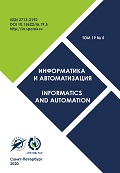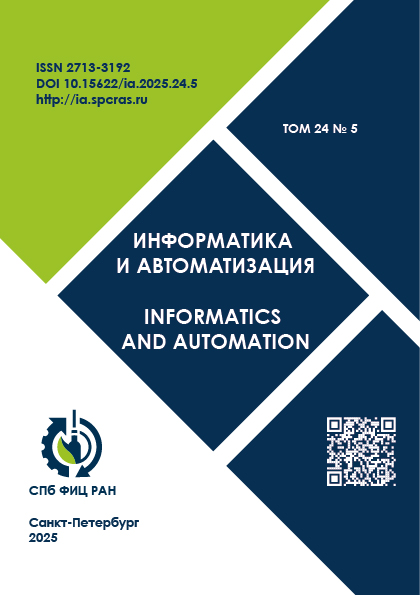Model of a Critical Information Infrastructure Cloud Platform with Cyber Immunity
Keywords:
cloud computing, computation semantics, critical information infrastructure, cyber resilience, cyberattacks, cyber immunityAbstract
The research is devoted to solving the problem of synthesizing a model of a critical information infrastructure cloud platform with cyber immunity. The relevance of the research is due to the need to resolve a problematic situation characterized by contradictions in science and practice. The contradiction in practice is observed between increased requirements for the resilience of critical information infrastructure cloud platforms and the growth of threats associated with the exploitation of previously unknown vulnerabilities and the overcoming of protective measures. The contradiction in science is that it is impossible to ensure the required resilience of such platforms using existing models and methods. Thus, existing approaches do not fully account for the specific features of critical information infrastructure cloud platforms, such as hierarchical architecture, the presence of undetected vulnerabilities, operation under targeted cyberattacks, increased requirements for resilience, and the need for rapid restoration of normal operation. This paper aims to synthesize a new model of a critical information infrastructure cloud platform with cyber immunity. A hypothesis has been formulated that endowing cloud platforms with the property of cyber immunity has a positive effect on their resilience when subjected to cyberattacks. Research methods include methods of system analysis, probability theory, theory of formal semantics, theory of similarity and dimensional analysis, as well as cyber immunology methods. The concept of cyber immunity has been substantiated, which involves providing cloud platforms with the ability to counteract known and previously unknown cyberattacks, quickly restore normal operation, and memorize malicious input data, thereby preventing their processing in the future. The indicators of the resilience of critical information infrastructure cloud platforms have also been substantiated. A new model of a critical information infrastructure cloud platform with cyber immunity has been developed. The scientific novelty of the proposed model lies in the introduction, for the first time, of components such as a semantic violation detector, a normal operation restorer, and cyber immune memory. These components collectively implement a new emergent property of cyber immunity. Theoretical and experimental studies of the model have been conducted, confirming the proposed hypothesis. The practical significance of the research results lies in providing technical recommendations on the architecture of the software complex, which can be applied in the development of means for protecting critical information infrastructure cloud platforms, in particular, the GosTech cloud platform, against cyberattacks.
References
2. Официальный сайт компании «Солар». Тренды кибератак на промышленность и телеком в 2025 году. Available at: https://rt-solar.ru/analytics/reports/5522/ (accessed 09.06.2025). (In Russ.).
3. Официальный сайт «РИА Новости». Гендиректор «Солара» рассказал о росте числа кибератак на Россию. Available at: https://ria.ru/20250606/gk-2021325615.html (accessed 09.06.2025). (In Russ.).
4. Zegzhda D.P., Aleksandrova E.B., Kalinin M.O., et al. Kiberbezopasnost' tsifrovoy industrii. Teoriya i praktika funktsional'noy ustoychivosti k kiberatakam [Cybersecurity of the Digital Industry: Theory and Practice of Functional Resilience to Cyberattacks]. Moscow: Nauchno-tekhnicheskoe izdatel'stvo «Goryachaya liniya-Telekom». 2021. 560 p. (In Russ.).
5. Pavlenko E.Yu., Shtyrkina A.A., Zegzhda D.P. [Estimating the Cyber-Physical System Sustainability Based on Spectral Graph Theory]. Problemy informatsionnoy bezopasnosti. Komp'yuternye systemy – Problems of information security. Computer systems. 2019. no. 1. pp. 60–68. (In Russ.).
6. Saenko I.B., Kotenko I.V., Lauta O.S., Skorobogatov S.Yu. [Sustainability Assessment Methodology Software-Configurable Networks in the Conditions of Computer Attacks]. I-methods. 2023. vol. 15. no. 1. (In Russ.).
7. Saenko I.B., Kotenko I.V., Lauta O.S., Skorobogatov S.Yu. [Computer Attack Models on Software-Configurable Networks]. Naukoemkie tekhnologii v kosmicheskikh issledovaniyakh Zemli – High technologies in earth space research. 2023. vol. 15. no. 1. pp. 37–47. DOI: 10.36724/2409-5419-2023-15-1-37-47. (In Russ.).
8. Biryukov D., Lomako A., Rostovtsev Y. The Appearance of Anticipating Cyber Threats Risk Prevention Systems. SPIIRAS Proceedings. Труды СПИИРАН. 2015. no. 2(39). pp. 5–25. DOI: 10.15622/sp.39.1. (In Russ.).
9. Andrushkevich D.V., Biryukov D.N., Timashov P.V. [Synthesis of Computer Attack Prevention Scenarios Based on a Logical-Ontological Approach]. Trudy Voenno-kosmicheskoy akademii imeni A.F. Mozhayskogo – Proceedings of the A.F. Mozhaysky Military Space Academy. 2021. no. 677. pp. 118–134. (In Russ.).
10. Kubrin G.S., Zegzhda D.P. [Vulnerability Detection in Multicomponent Software Using a Set of Generalized Code Graph Representations]. Problemy informatsionnoy bezopasnosti. Komp'yuternye systemy – Problems of information security. Computer systems. 2024. no. S2(60). pp. 65–75. DOI: 10.48612/jisp/nb67-m5g8-mpae. (In Russ.).
11. Chevtchenko S.F., et al. Anomaly Detection in Industrial Machinery Using IoT Devices and Machine Learning: A Systematic Mapping. IEEE Access. 2023. vol. 11. pp. 128288–128305. DOI: 10.1109/ACCESS.2023.3333242.
12. Nand K., Zhang Z., Hu J. A Comprehensive Survey on the Usage of Machine Learning to Detect False Data Injection Attacks in Smart Grids. IEEE Open Journal of the Computer Society. 2025. vol. 6. pp. 1121–1132. DOI: 10.1109/OJCS.2025.3585248.
13. Hao W., Yang T., Yang Q. Hybrid Statistical-Machine Learning for Real-Time Anomaly Detection in Industrial Cyber–Physical Systems. IEEE Transactions on Automation Science and Engineering. 2023. vol. 20. no. 1. pp. 32–46. DOI: 10.1109/TASE.2021.3073396.
14. Ozdogan E. A Comprehensive Analysis of the Machine Learning Algorithms in IoT IDS Systems. IEEE Access. 2024. vol. 12. pp. 46785–46811. DOI: 10.1109/ACCESS.2024.3382539.
15. Novikova E.S., Kotenko I.V., Meleshko A.V., Izrailov K.E. [Federated Learning Based Intrusion Detection: System Architecture and Experiments]. Voprosy kiberbezopasnosti – Cybersecurity issues. 2023. no. 6(58). pp. 50–66. DOI: 10.21681/2311-3456-2023-6-50-66. (In Russ.).
16. Aljuaid W.H., Alshamrani S.S. A deep learning approach for intrusion detection systems in cloud computing environments. Applied sciences. 2024. vol. 14. no. 13. DOI: 10.3390/app14135381.
17. Alrayes F.S., Zakariah M., Amin S.U., Iqbal Khan Z., Helal M. Intrusion Detection in IoT Systems Using Denoising Autoencoder. IEEE Access. 2024. vol. 12. pp. 122401–122425. DOI: 10.1109/ACCESS.2024.3451726.
18. Liu X., Xie L., Wang Y., Zou J., Xiong J., Ying Z. Privacy and Security Issues in Deep Learning: A Survey. IEEE Access. 2021. vol. 9. pp. 4566–4593. DOI: 10.1109/ACCESS.2020.3045078.
19. Burlakov M.E., Ivkin A.N. [Intrusion Detection System Based on the Artificial Immune System]. Vestnik Permskogo natsional'nogo issledovatel'skogo politekhnicheskogo universiteta. Elektrotekhnika, informatsionnye tekhnologii, sistemy upravleniya – Bulletin of Perm National Research Polytechnic University. Electrical Engineering, Information Technologies, and Control Systems. 2019. no. 29. pp. 209–224. (In Russ.).
20. Shamsutdinov R.R., Vasil'ev V.I., Vul'fin A.M. [Intelligent System for Monitoring Information Security of the Industrial Internet of Things using Artificial Immune Systems Mechanisms]. Sistemnaya inzheneriya i informatsionnye tekhnologii – Systems engineering and information technologies. 2024. vol. 6. no. 4(19). pp. 14–31. DOI: 10.54708/2658-5014-SIIT-2024-no4-p14. (In Russ.).
21. Branitskiy A.A., Kotenko I.V. [Network Attack Detection Based on Combination of Neural, Immune and Neuro-Fuzzy Classifiers]. Informatsionno-upravlyayushchie sistemy – Information and control systems. 2015. no. 4(77). pp. 69–77. DOI: 10.15217/issn1684-8853.2015.4.69. (In Russ.).
22. Dutt I., Borah S., Maitra I.K. Immune System Based Intrusion Detection System (IS-IDS): A Proposed Model. IEEE Access. 2020. vol. 8. pp. 34929–34941. DOI: 10.1109/ACCESS.2020.2973608.
23. Aldhaheri S., Alghazzawi D., Cheng L., Alzahrani B., Al-Barakati A. DeepDCA: Novel Network-Based Detection of IoT Attacks Using Artificial Immune System. Appl. Sci. 2020. vol. 10(6). DOI: 10.3390/app10061909.
24. Gijsen B., Montalto R., Panneman J., Falconieri F., Wiper P., Zuraniewski P. Self-Healing for Cyber-Security. Sixth International Conference on Fog and Mobile Edge Computing (FMEC). 2021. pp. 1–7. DOI: 10.1109/FMEC54266.2021.9732575.
25. Pinto C., Pinto R., Gonçalves G. Towards Bio-Inspired Anomaly Detection Using the Cursory Dendritic Cell Algorithm. Algorithms. 2022. vol. 15(1). DOI: 10.3390/a15010001.
26. Bereta M. Negative selection algorithm for unsupervised anomaly detection. Applied sciences. 2024. vol. 14. no. 23. DOI: 10.3390/app142311040.
27. Jerbi M., Dagdia Z.C., Bechikh S., Said L.B. Immune-based system to enhance malware detection. IEEE congress on evolutionary computation (CEC). 2023. pp. 1–8. DOI: 10.1109/CEC53210.2023.10254159.
28. Voevodin V.A. [On the formulation of the task of assessing the stability of the functioning of critical information infrastructure facilities]. Voprosy kiberbezopasnosti – Cybersecurity issues. 2025. no. 1(65). pp. 41–49. DOI: 10.21681/2311-3456-2025-1-41-49. (In Russ.).
29. Balyabin A.A., Petrenko S.A. [A self-healing model for cyber-physical systems of the Russian Federation's critical information infrastructure under cyberattacks based on cyber-immunity]. Sb. tr. IX Mezhdunar. nauchn.-tekhn. konf. (CDE'25) [The 2025 Symposium on Cybersecurity of the Digital Economy (CDE'25): Collected papers]. 2025. pp. 76–91. (In Russ.).
30. Petrenko S.A. Kiberimmunologiya: nauchnaya monografiya [Cyber Immunology]. Saint Petersburg: Izdatel'skiy dom «Afina». 2021. 239 p. (In Russ.).
31. Petrenko S.A. Kiberustoychivost' industrii 4.0 [Cyber Resilience Industry 4.0]. Saint Petersburg: Izdatel'skiy dom «Afina». 2020. 256 p. (In Russ.).
32. Balyabin A.A. Threats to the Resilience of Cloud Platforms. XXVII International Conference on Soft Computing and Measurements (SCM). 2024. pp. 246–249. DOI: 10.1109/SCM62608.2024.10554080.
33. Balyabin A.A. Ensuring the Resilience of Cloud Platforms Based on Cyber Immunity. XXVII International Conference on Soft Computing and Measurements (SCM). 2024. pp. 233–237. DOI: 10.1109/SCM62608.2024.10554277.
34. Balyabin A.A. [Model of the Cloud Platform of Critical IT Infrastructure of the Russian Federation Under the Conditions of Information Technology Impacts]. Zaŝita informacii. Inside – Information protection. Inside. 2024. no. 5(119). pp. 35–44. (In Russ.).
35. Kharzhevskaya A., Lomako A., Petrenko S. [Representing programs with similarity invariants for monitoring tampering with calculations]. Voprosy kiberbezopasnosti – Cybersecurity issues. 2017. no. 2(20). pp. 9–20. DOI: 10.21581/2311-3456-2017-2-9-20. (In Russ.).
Published
How to Cite
Section
Copyright (c) Артём Алексеевич Балябин, Сергей Анатольевич Петренко

This work is licensed under a Creative Commons Attribution 4.0 International License.
Authors who publish with this journal agree to the following terms: Authors retain copyright and grant the journal right of first publication with the work simultaneously licensed under a Creative Commons Attribution License that allows others to share the work with an acknowledgement of the work's authorship and initial publication in this journal. Authors are able to enter into separate, additional contractual arrangements for the non-exclusive distribution of the journal's published version of the work (e.g., post it to an institutional repository or publish it in a book), with an acknowledgement of its initial publication in this journal. Authors are permitted and encouraged to post their work online (e.g., in institutional repositories or on their website) prior to and during the submission process, as it can lead to productive exchanges, as well as earlier and greater citation of published work (See The Effect of Open Access).






